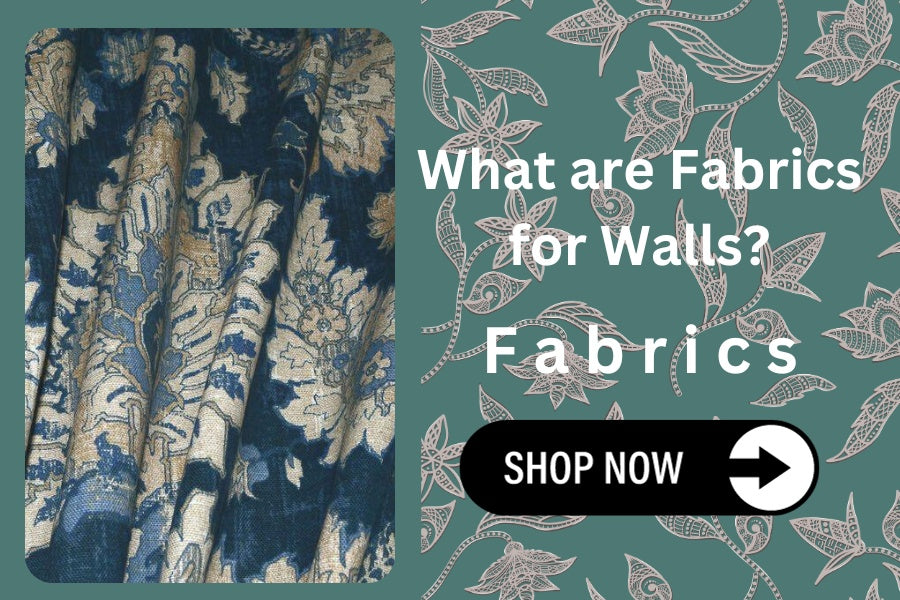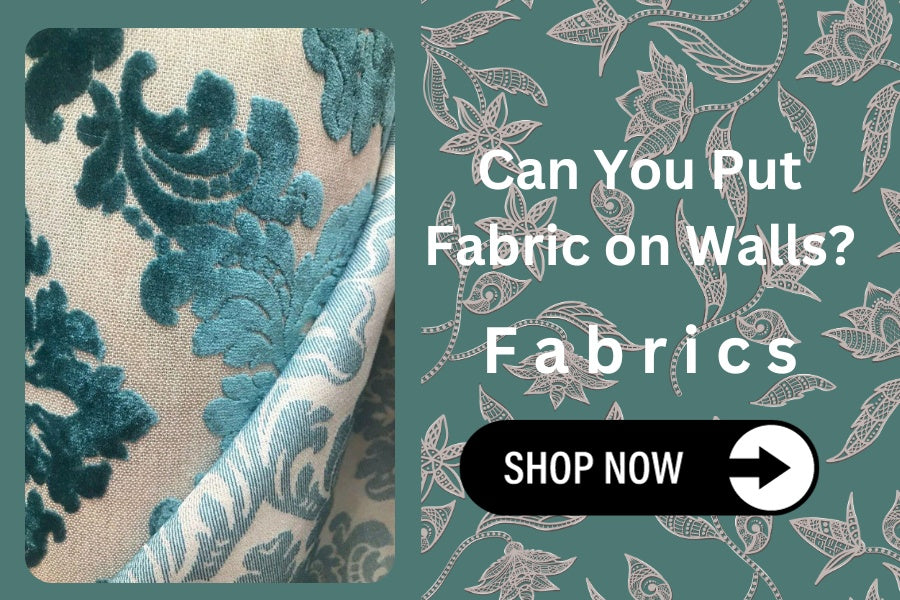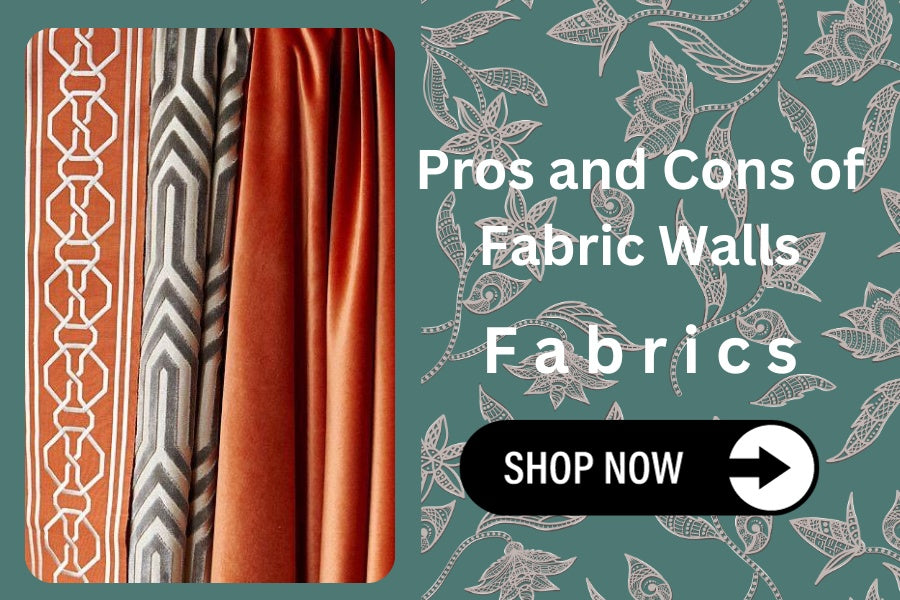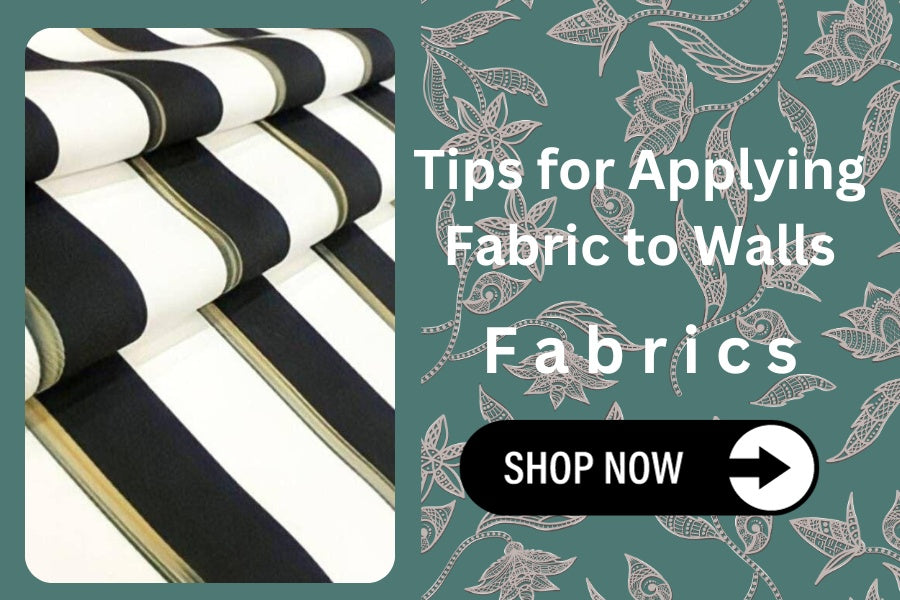When it comes to interior design, walls play a crucial role in setting the tone for a space. While paint and wallpaper have long been popular choices, there's a rising trend that adds a touch of luxury and creativity to walls — using fabrics. In this comprehensive guide, we'll delve into the world of "Fabrics for Walls," exploring what it is, the process of application, the pros and cons, and the best fabrics to elevate your interior aesthetic.
What are Fabrics for Walls?

Fabrics for walls represent a transformative approach to interior design, introducing texture, warmth, and visual interest to living spaces. This innovative concept involves the application of fabric directly onto walls, turning them into dynamic design elements that go beyond traditional paint or wallpaper. The selection of fabric becomes a crucial aspect, allowing individuals to tailor their choices based on personal style preferences, desired ambiance, and the overarching design theme of the room.
Key Features of Fabrics for Walls
- Texture Enhancement: Fabrics introduce tactile elements, enriching the sensory experience within a room.
- Warmth and Comfort: The softness of fabric creates a cozy atmosphere, making it an ideal choice for communal areas.
- Unlimited Design Options: The versatility of fabrics opens up a plethora of design possibilities, from subtle patterns to bold prints.
- Concealing Imperfections: Fabric can effectively mask wall imperfections, ensuring a smooth and flawless appearance.
Can You Put Fabric on Walls?

Certainly! Applying fabric to walls is a versatile and customizable technique that has gained significant popularity, especially within the realm of luxury interior design. The process involves adhering carefully chosen fabrics directly onto the walls, allowing for a unique and personalized aesthetic.
Related Products:
| Pillow & Cushions | |
Notably, companies like Angie Homes have been pioneers in introducing cutting-edge fabric solutions to the market, offering a range of innovative options for those looking to elevate their living spaces.
Advantages of Using Fabric on Walls
- Luxurious Aesthetic: Fabric imparts a sense of opulence and sophistication, elevating the overall look of the room.
- Acoustic Benefits: Certain fabrics can absorb sound, contributing to a quieter and more comfortable environment.
- Customization: From the choice of fabric to the application technique, the level of customization is unparalleled.
- Versatility: Fabric can be applied to entire walls, used as panels, or incorporated into specific design elements, providing flexibility in design.
Pros and Cons of Fabric Walls

Pros:
- Versatility: Fabrics provide an extensive range of colors, patterns, and textures, allowing for unlimited design possibilities.
- Acoustic Benefits: Fabric can absorb sound, making it an excellent choice for spaces where noise reduction is essential.
- Warmth and Comfort: Fabric creates a cozy and inviting atmosphere, making it ideal for bedrooms, living rooms, and other communal areas.
- Hide Imperfections: Fabric can effectively conceal wall imperfections, providing a smooth and flawless appearance.
Cons:
- Maintenance: Certain fabrics may require more maintenance, and cleaning can be challenging.
- Installation Complexity: Applying fabric to walls might be more intricate than traditional wall coverings, requiring proper techniques for a seamless finish.
- Durability: Depending on the fabric chosen, durability may be a concern, especially in high-traffic areas.
Tips for Applying Fabric to Walls

Achieving a flawless and visually stunning fabric wall requires attention to detail and proper execution. Follow these detailed tips to ensure a successful application that transforms your space with texture and style.
1. Surface Preparation
Before applying fabric to walls, thorough surface preparation is essential for a smooth and long-lasting finish. Follow these steps:
Detailed Steps:
- Clean the Wall: Remove dust, dirt, and any debris from the wall surface using a gentle cleaner. This ensures proper adhesion and a clean canvas for the fabric.
- Repair Imperfections: Address any wall imperfections such as cracks or holes. Fill them with a suitable wall filler and sand the surface to create an even base.
- Smooth Finish: Achieve a smooth finish by sanding the entire wall surface lightly. This step is crucial for preventing bumps or uneven areas under the fabric.
2. Proper Adhesive:
Choosing the right adhesive is crucial for the success of your fabric wall application. Different fabrics may require specific adhesives. Follow these detailed recommendations:
Detailed Steps:
- Fabric Compatibility: Consider the type of fabric you're using and choose an adhesive recommended for that specific fabric. Angie Homes provides quality adhesive solutions designed for various fabric types.
- Adhesive Testing: Before applying the fabric to the entire wall, perform a small test in an inconspicuous area to ensure compatibility and adhesion strength.
- Even Application: Apply the adhesive evenly across the wall surface using a paint roller or brush. Ensure complete coverage, especially at the edges and corners.
3. Stretching:
Properly stretching the fabric is crucial for achieving a smooth and wrinkle-free appearance. Follow these detailed steps:
Detailed Steps:
- Start from the Center: Begin attaching the fabric from the center of the wall and work your way outward. This helps distribute tension evenly.
- Smooth Out Wrinkles: As you press the fabric onto the adhesive, use a smooth, flat tool, such as a wallpaper smoother, to eliminate wrinkles or bubbles. Work from the center towards the edges.
- Tighten as You Go: Continuously tighten the fabric as you progress to prevent sagging. Regularly step back and assess the tension to ensure a uniform stretch.
4. Trimming:
Careful trimming of excess fabric is crucial for achieving a polished and professional look. Follow these detailed steps:
Detailed Steps:
- Wait for Adhesive to Dry: Allow the adhesive to dry completely before trimming the excess fabric. This ensures that the fabric is securely adhered to the wall.
- Use Sharp Tools: Use sharp scissors or a utility knife to trim the excess fabric along the edges and corners. A clean, precise cut contributes to a neat appearance.
- Detail Work: Pay special attention to detail work around features like outlets, switches, or architectural elements. Make precise cuts to accommodate these features seamlessly.
By meticulously following these detailed tips, you can navigate the fabric wall application process with confidence and precision. Whether you're a DIY enthusiast or working with a professional, the key lies in thorough preparation, the right adhesive selection, careful stretching, and precise trimming. With these steps, you'll be on your way to transforming your space into a visually stunning masterpiece that reflects your unique style.
For top-quality adhesive solutions and expert guidance, consider products from Angie Homes, a leading name in innovative fabric solutions. Elevate your interior design with the luxury and customization that fabric walls can bring to your living spaces.
Best Fabrics for Fabric Walls

The choice of fabric can significantly impact the overall aesthetic of your walls. Here are some top contenders:
- Linen: Linen offers a natural and textured look, bringing a relaxed yet sophisticated vibe to a space.
- Velvet: For a touch of luxury and opulence, velvet fabric adds depth and richness to walls.
- Cotton: Versatile and easy to maintain, cotton fabric is available in various patterns and colors, making it suitable for different styles.
- Silk: If you're aiming for a luxurious and elegant feel, silk fabric on walls can create a stunning visual impact.
- Burlap: For a more rustic and earthy look, burlap fabric provides a textured and organic feel to the walls.
- Faux Leather: Ideal for creating a modern and edgy atmosphere, faux leather adds a contemporary touch to interiors.
- Chenille: Soft and plush, chenille fabric is perfect for creating a cozy and inviting space.
- Brocade: This fabric is characterized by intricate patterns and metallic threads, adding a touch of glamour to walls.
- Tapestry: For a bohemian or eclectic style, tapestry fabric can introduce vibrant colors and patterns.
- Damask: Damask fabric features elaborate patterns, often in a single color, providing a classic and timeless look to walls.
Top 10 Fabric on Walls Ideas

- Accent Wall: Create a focal point by applying fabric to one wall, adding drama and interest to the room.
- Textured Panels: Use fabric panels to break up large wall spaces, introducing texture and visual appeal.
- Ceiling Canopies: Extend fabric from the walls to the ceiling to create a cozy canopy effect.
- Custom Murals: Print custom designs on fabric to create unique and personalized wall murals.
- Mix and Match: Experiment with different fabrics in the same space for a dynamic and eclectic look.
- Headboard Wall: Apply fabric behind the bed to serve as a stylish and soft headboard alternative.
- Geometric Patterns: Create geometric shapes or patterns using fabric panels for a modern and artistic touch.
- Floor-to-Ceiling Elegance: Extend fabric from the floor to the ceiling for a seamless and elegant appearance.
- Layered Fabrics: Combine different fabrics to add depth and dimension to your walls.
- Themed Spaces: Use themed fabrics to evoke a specific atmosphere, such as nautical, tropical, or vintage.
How to Cover a Wall With Fabric

- Prepare the Wall: Clean and prime the wall surface to ensure proper adhesion.
- Cut the Fabric: Measure and cut the fabric to fit the wall, leaving a few extra inches for trimming.
- Apply Adhesive: Use a suitable adhesive for fabric walls, applying it evenly on the wall.
- Smooth Application: Carefully press the fabric onto the adhesive, starting from the top and smoothing it down to avoid air bubbles.
- Trim Excess: Once the fabric is applied, trim the excess using a sharp utility knife.
- Seamless Finish: Ensure edges and seams are well-secured for a seamless finish.
Conclusion
Using fabrics for walls is a trend that seamlessly blends creativity and functionality in interior design. Whether you prefer the timeless elegance of silk or the relaxed charm of linen, the possibilities are endless. Angie Homes, a leading name in the industry, has been instrumental in introducing high-quality fabric solutions, contributing to the evolution of interior design trends.
Experiment with different fabrics, embrace various application ideas, and transform your space into a personalized sanctuary. With the right fabric choice and application techniques, you can achieve a unique and visually stunning interior that reflects your style and personality.
Related Posts :
How To Pair Fabric and Wallpaper : A Comprehensive Guide
Walls That Wow: Enhancing Your Decor with Stylish Wall Sconces
How to Cover a Wall With Fabric: Transform Your Space with Angie Homes
All You Need to Know About Fabric Wallpaper
FAQ's (Frequently Asked Questions)

Q. How Do You Clean Wall Fabric?
Ans: Cleaning wall fabric depends on the type of fabric used. Most fabrics can be spot-cleaned with a mild detergent or professionally cleaned. Always check the manufacturer's guidelines for cleaning instructions.
Q. What Glue Is Best for Wall Fabric?
Ans: Choosing the right adhesive is crucial. Angie Homes provides quality adhesive solutions suitable for various fabric types. Always follow the manufacturer's recommendations for the specific fabric and wall surface.
Q. What Kind of Fabric is Best for Walls?
Ans: The best fabric for walls depends on your design preferences and the desired ambiance. Options like linen, velvet, cotton, and silk offer different textures and aesthetics. Consider the style of the space and the maintenance requirements of the fabric.
Q. Can I put fabric on my walls?
Ans: Yes, fabric can be applied to walls to enhance their aesthetic appeal. It's a creative and customizable solution that allows you to transform your space according to your style and preferences.
Q. What are the different types of wall fabric?
Ans: Different types of wall fabric include linen, velvet, cotton, silk, burlap, faux leather, chenille, brocade, tapestry, and damask. Each type offers unique textures and visual characteristics suitable for various design concepts.
